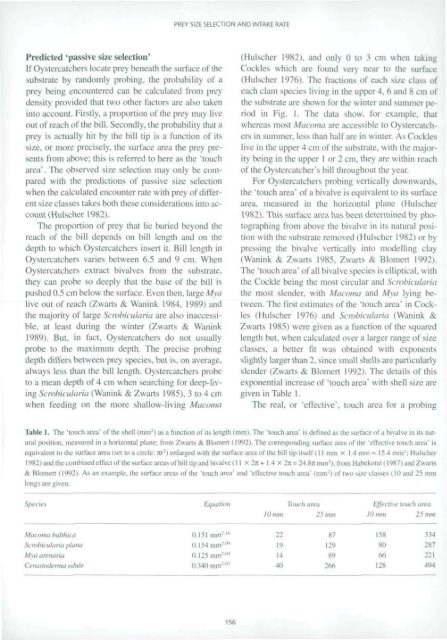waders and their estuarine food supplies - Vlaams Instituut voor de ...
waders and their estuarine food supplies - Vlaams Instituut voor de ...
waders and their estuarine food supplies - Vlaams Instituut voor de ...
Create successful ePaper yourself
Turn your PDF publications into a flip-book with our unique Google optimized e-Paper software.
Predicted 'passive size selection'<br />
If Oystercatchers locale prey beneath the surface of ihe<br />
substrate by r<strong>and</strong>omly probing, the probability of a<br />
prey being encountered can he calculated Irom prey<br />
<strong>de</strong>nsity provi<strong>de</strong>d that two other factors are also taken<br />
into account. Firstly, a proportion of the prey mav live<br />
out of reach of the bill. Secondly, the probability that a<br />
prey is actually nil by ihe bill lip is a function of its<br />
size, or more precisely, the surface area the prey presents<br />
from above: this is referred to here as the 'touch<br />
area'. The observed si/e selection may only be compared<br />
with the predictions of passive si/e selection<br />
when the calculated encounter rate with prey of different<br />
si/e classes takes both these consi<strong>de</strong>rations into account<br />
(Hulscher 1982).<br />
The proportion of prey that lie buried beyond the<br />
ieach of the bill <strong>de</strong>pends on bill length <strong>and</strong> on the<br />
<strong>de</strong>pth to which Oystercatchers insert it. Bill length in<br />
Oystercatchers varies between 6.5 <strong>and</strong> 9 cm. When<br />
Oystercatchers extract bivalves from the substrate.<br />
they can probe so <strong>de</strong>eply that the base of the bill is<br />
pushed 0.5 cm below the surface. Even then, large Mya<br />
live out of reach (Zwarts & Wanink 1984, 1989) <strong>and</strong><br />
the majority of large Scrobicularia are also inaccessible,<br />
at least during ihe winter (Zwarts & Wanink<br />
1989). But. in fact, Oystercatchers do not usually<br />
probe to the maximum <strong>de</strong>pth. The precise probing<br />
<strong>de</strong>pth differs between prey species, but is. on average.<br />
always less than ihe bill lengih. Oystercatchers probe<br />
to a mean <strong>de</strong>pth of 4 cm when searching for <strong>de</strong>ep-living<br />
Scrobicularia (Wanink & Zwarts 1985), 3 to4cm<br />
when feeding on the more shallow-living Macoma<br />
PREY SIZE SELECTION AND INTAKE RATE<br />
(Hulscher 1982). <strong>and</strong> only 0 to 3 cm when taking<br />
Cockles which are found very near to the surface<br />
(Hulscher 1976). The fractions of each si/e class oi<br />
each clam species liv ing in the upper 4. 6 <strong>and</strong> 8 cm of<br />
the substrate are shown for the w inter <strong>and</strong> summer period<br />
in Fig. 1. The dala show, for example, thai<br />
whereas most Macoma are accessible lo Oystercatchers<br />
in summer, less than half are in winter. As Cockles<br />
live in ihe upper 4 cm of the substrate, with the majority<br />
being in the upper 1 or 2 cm. ihey are within reach<br />
of the Oysiercatcher's bill throughout the year.<br />
For Oystercatchers probing vertically downwards,<br />
the 'touch area" ol a bivalve is equivalent to its surface<br />
area, measured in the horizontal plane (Hulscher<br />
1982). This sin lace area has been <strong>de</strong>termined by photographing<br />
from above the bivalve in iis natural position<br />
wilh the substrate removed (Hulscher 1982) or by<br />
pressing the bivalve vertically into mo<strong>de</strong>lling clav<br />
i Wanink & Zwarts [985, ZwaitS & Blomert 1992).<br />
The 'touch area' of all bivalve species is elliptical, with<br />
the Cockle being the most circular <strong>and</strong> Scrobicularia<br />
the mosi slen<strong>de</strong>r, with Macoma <strong>and</strong> Mya lying between.<br />
The first estimates of the 'touch area" in Cockles<br />
(Hulscher 1976) <strong>and</strong> Scrobicularia (Wanink &<br />
Zwarts 1985) were given as a function of the squared<br />
lengih but. when calculated over a larger range of si/e<br />
classes, a better lit was obtained with exponents<br />
slightly larger than 2. since small shells are paiticularlj<br />
slen<strong>de</strong>r (Zwarts & Blomert 1992). The <strong>de</strong>tails of this<br />
exponential increase of 'touch area' with shell si/e are<br />
given in Table I.<br />
The real, or 'effective', touch area for a probing<br />
Tabic I. The 'Much area' of the shell imm-'i as a function oi us length i mini. The "touch area' is <strong>de</strong>fined as the snftceofa bivalve in us natural<br />
position, measured in a horizontal plane: (iron* Zwarts .V. Blomert (1992). The corresponding surface area of Ihe effective touch area' is<br />
equivalent Io the surface area lset to a circle: nr) enlarge! vmh the surface area of the bill lip itself (I I mm x I 4 nun = 15.4 mm': HuKchei<br />
1982) <strong>and</strong> the combined ciicct ot the surface areas of hill tip <strong>and</strong> bivalve (11 x 2n+ 1.4 x 2jt=24.8*1 ram 2 ); fromllabekotteil l 'X7)<strong>and</strong>/u.Mis<br />
& Blomert 11992). As an example. Ihc surface areas ol the touch area' <strong>and</strong> 'effective touch area' (mm 1 ) nl two si/e classes i II) <strong>and</strong> 25 nun<br />
long) are given.<br />
Spei us Equation Touch area<br />
It) mm 25 nun<br />
Macoma balthica<br />
Si mhii ularia plana<br />
Msu arenaria<br />
Cerasto<strong>de</strong>rma edule<br />
0.151 mm-' 1 "<br />
I) 154 mm '"<br />
(I.i:5iiim" ' !<br />
0.340 mm-" ;<br />
156<br />
22<br />
19<br />
14<br />
-111<br />
87<br />
129<br />
89<br />
266<br />
t touch area<br />
10 mm 25 "»'i<br />
158<br />
80<br />
66<br />
128<br />
287<br />
221<br />
494

















